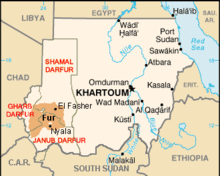Fur language
| Fur | |
|---|---|
| bèle fòòr فوراوي | |
| Native to | Sudan, Chad |
| Region | Darfur |
| Ethnicity | 900,000 Fur people (2014) |
|
Native speakers
|
745,000 (2004) |
|
Nilo-Saharan?
|
|
| Language codes | |
| ISO 639-3 | |
| Glottolog | furr1244 |
| Linguasphere | 05-CAA-aa |

Geographic distribution of Fur
|
|
The Fur language (Fur bèle fòòr or fòòraŋ bèle; Arabic: فوراوي Fûrâwî; sometimes called Konjara by linguists, after a former ruling clan) is a Nilo-Saharan language spoken by the Fur of Darfur in western Sudan. It is one of the Fur languages.
The consonantal phonemes are:
All sounds are spelt with their IPA symbols except for the following: j = [ɟ], ñ = [ɲ] and y = [j]. Arabic consonants are sometimes used in loanwords.
The vowels are as in Latin: a e i o u. There is dispute as to whether the –ATR vowels [ɛ], [ɔ], [ɪ], [ʊ] are phonetic variants or separate phonemes.
There are two underlying tonemes, L (low) and H (high); phonetically, L, H, mid, HL and LH are all found.
Metathesis is an extremely common and regular grammatical phenomenon in Fur: when a consonant pronoun prefix is prefixed to a verb that begins with a consonant, either the verb's first consonant is deleted or it changes places with the following vowel. E.g.: lem- "lick" → -elm-; ba- "drink" → -ab-; tuum- "build" → -utum-. There are also various assimilation rules.
Noun, and optionally adjective, plurals can be formed with -a (-ŋa after vowels): àldi "story" → àldiŋa "stories", tòŋ "(a certain species of) antelope" → tòŋà "antelopes"; bàin "old" → bàinà "old (pl.)". This suffix also gives the inanimate 3rd person plural of the verb: lìiŋ "he bathes" → lìiŋa "they (inanimate) bathe", kaliŋa "they (animate) bathe".
Vowel-final adjectives can take a plural in -là, as well as -ŋa: lulla "cold" → lullalà or lullaŋà "cold (pl.)". A similar suffix (metathesized and assimilated to become -òl/-ùl/-àl) is used for the plural of the verb in some tenses.
...
Wikipedia
